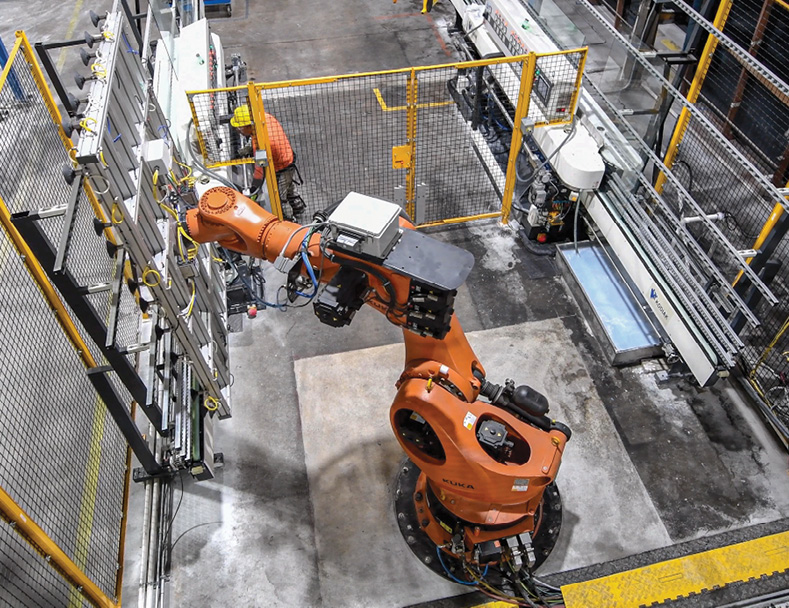Q + A with Salem | Helping to Manufacture the Future
Salem prepares glass fabricators for efficiency with end-to-end solutions

Above: HHH Equipment Resources two KODIAK® robotic cell. Photo by HHH Equipment Resources
 Glass fabricators are staying the course in 2023 despite slow growth, uncertain market conditions, persistent labor shortages, rocky supply chain conditions and production challenges. The industry is still locked in the mindset of doing more with less, possibly more so than ever before as a majority of fabricators, 65 percent, reported to Glass Magazine that they automated some part of their manufacturing process in 2022. A majority, 66 percent, also said that they would automate processes in 2023, including the addition of new insulating glass lines, jumbo glass cutting lines and laminating lines.
Glass fabricators are staying the course in 2023 despite slow growth, uncertain market conditions, persistent labor shortages, rocky supply chain conditions and production challenges. The industry is still locked in the mindset of doing more with less, possibly more so than ever before as a majority of fabricators, 65 percent, reported to Glass Magazine that they automated some part of their manufacturing process in 2022. A majority, 66 percent, also said that they would automate processes in 2023, including the addition of new insulating glass lines, jumbo glass cutting lines and laminating lines.
With more than 100 years of experience, Salem Fabrication Technologies Group Inc.—through its Salem Fabrication Supplies and HHH Equipment Resources divisions—brings complete and customizable surfacing supplies, quality polishing tools and glass fabrication machinery equipment to the glass industry. Headquartered in Winston-Salem, North Carolina, the Salem team takes a guided approach to preparing glass fabricators and glazing professionals with end-to-end glass fabrication solutions as well as specialist consultation, maintenance and service to help provide solutions to customers’ challenges.
Glass Magazine spoke with Mike Synon, president of HHH Equipment Resources, and Ashley Price, Eastern regional sales director at Salem Fabrication Supplies, about end-to-end glass fabrication, the challenges and opportunities involved with integrating automated machinery into a fabrication plant, and how Salem’s product and process expertise can help customers navigate current industry challenges. Synon has been with the company since 2013 and brings more than 24 years of industry experience, including involvement within the manufacturing, fabrication and installation sides of the glass industry. Meanwhile, Price joined the company in 2010 and has more than 23 years of experience in the glass and stone fabrication industries working as a CNC technician and tooling specialist with both U.S. companies and Italian machinery manufacturers.
Let’s start with your customers. What are their pain points right now? What are they asking for and how are you providing for them?
Mike Synon: From the machinery aspect, employment seems to be the largest pain point—finding people, getting them on the payroll, training them and maintaining training through turnover. [Customers are] consistently asking us for robotic systems, automatic grinders to seam their glass before it goes into the tampering furnace. Anything that can eliminate a body, so to speak.
Ashley Price: Supply chain is one of the biggest pain points right now. Lead times continue to extend, a shortage in raw materials, and energy cost increases really create a burden for our customers. Cost increases on our consumable products have affected us across the board and we have to be diligent in how we manage that inventory for our customers. We continually look at alternative options and bring in multiple lines of products that offer good-better-best options for our customers.
What are the top challenges for glass companies in integrating automated machinery into a fabrication plant?
MS: First of all, there are the space requirements. It takes additional space to put the automated machinery in and get those systems set up. The other thing is the cost of investment in automation. ... However, if a fabricator is feeling the crunch and the pain of staffing, they’ll make the investment.
AP: Adding to that, you need competent operators and maintenance staff. You have to combine the challenge of training those individuals with the capabilities of the machines; knowing up front what each can and can’t do. Do you have confident people that can retain information and perform those duties of operation? The maintenance staff needs to be knowledgeable enough to work on any new piece of equipment in conjunction with the machine partner’s technical service department. Also, when you talk about automated equipment, you have to consider the quality of the consumable supplies used that are crucial to the performance of each piece of machinery.
If a fabricator is new to adding automated solutions, where should they look first or what do they need to know?
MS: What they should do first is to check with every OEM, manufacturer and distributor to see what product line they’re offering and what the configurations are. And most importantly, determine what will be the fabricator’s responsibility in terms of service. … A fabricator is going to need a technical team to walk them through that process. Finally, consider maintenance. I don’t want to say that maintenance is a dying art, but there are a lot of factories we go to that have three tempering furnaces, five edgers and just one maintenance guy.
AP: Fabricators must also understand what they truly want. What processes are they really looking to automate? What are the limitations of that piece of equipment they are considering? Knowing the full capabilities of the machinery is absolutely necessary. There are so many different options and process conditions that you must think about along with technical service. Choosing a solution that has a U.S.-based service team to keep that machine up and running and in production at all times is important.
When a fabricator commits to adding automated machinery, what does that pre-planning look like?
MS: We start with the floorplan of the facility. We get a CAD drawing of the plant and then we work our way backwards from there, figuring where the machines will fit within the facility so they can analyze the flow and where they can gain time, reduce cost and so on. We can exchange drawings with fabricators 15 to 20 times before we decide on a location. You have to figure out where the electric’s coming in, if there’s enough amperage and the correct voltage.
You need to establish proper drainage—what are you going to do with the water? It’s a long, drawn-out process. Then comes the purchase, the installation, and the most important part, the service because this is all going to be new to the fabricator. It takes all of this to make a successful launch.
Let’s talk training. Automation makes things simple, but what are your fabricators’ top challenges when it comes to training their people, and how do you support them?
MS: Getting people comfortable with working with a robotic system and the technology is the first step. The install and commissioning of a vertical CNC takes approximately two weeks. We get them trained, get them running, and then we have our tooling guys come in and help them with the tooling setups and make sure that it’s all correct. We come back for one more week to correct mistakes and answer additional questions. That’s a three-week commitment to getting the machine up and running correctly.
AP: We have a multitude of training opportunities for tooling setup. From PowerPoint presentations and videos to in-person tooling specialists that will demonstrate how to perform a variety of operations. There are different forms of training for new hires or seasoned workers that cover tips, tricks and strategies to help further their education and knowledge on a specific process. Often, the main issue our customers face in training is retention of knowledge. We offer training to all customers, even when they’re not asking for it, because there are many operators on the floor that are afraid to ask questions that expose the fact that they are not comfortable in their job duties. The key for us is to educate each operator and give them the needed tools and knowledge so that we set them up for success.


